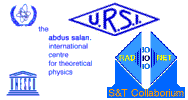|

|
|
|
|
|
|
|
|
|

|
|
ICTP
- URSI
SCHOOL ON DIGITAL AND MULTIMEDIA COMMUNICATIONS USING
TERRESTRIAL AND SATELLITE RADIO
LINKS
12th
February - 2nd March
2001 ,
Trieste
(Italy)
|
|
|
-
|
|
|
|
|
|
|
|
|
Laboratory
Diary: wednesday 21st
february
|
|
|
|
|
Laboratory Diary: wednesday 21st february
--------------------------------------
Date: Wed, 21 Feb 2001 21:13:55 +0100 (MET)
Prepared by: Daniel Obuobi <obuobid@ictp.trieste.it>
LABORATORY DIARY FOR 21/2/01
1. THE PROJECT
The day started with a detailed explanation of the project work
by C. FondaS. He explained what is required from all participants.
Partcipants were divided in four groups as follows
GROUP 1 - Science Faculty
Group 2 - Agruculture Faculty
GROUP 3 - LITERATURE
GROUP 4 - ECONOMICS
GROUP 5 - COMPUTER CENTRE
These groups were to work on the project considering realistic needs,
possibilities and constraints, required to plan and develop a Campus
Network. The were given options to choose from with respect to the
implementation of wireless links in a real life situation within each
building whilst stressing the dos and don'ts.
2. Line-Of-Sight and Not-LOS Wireless Links Planning
Next was a lecture on the Line-Of-Sight and Not-LOS Wireless Links
Planning. This lecture provied an insight into the nature of radio
propagation in the spectrum (upper VHF to microwave). It covered the
basics of free space path loss calculations, and then considers the
effects of refraction, diffraction and reflections on the path loss of
Line of Sight (LOS) links. The nature of non-LOS radio links is then
examined, and propagation effects other than path loss which are important
in digital transmission were also described.The class was given some
formulas from which actuall deductions could be made.
He stressed that the technology is changing as access to the Internet
becomes cheaper and faster. Also the fundamental aim of radio link is to
deliver sufficient signal power to the receiver at the other end.
Partcipants were taken through a number of examples. It was a very nice,
lively and interesting lecture.
3. PROJECT PLANNING
The last 35 minute of the morning session was devoted to planning of the
project in terms of the budget, technical specfication and implementaion.
The variables for the planning were logistic, technical and economic.
The keywords were PLANNING, COLLABORATION AND INTERNET.
In the afternoon session was even more interesting. Each group made a
presentation of how they hope to build the network to simulate the
typical campus network. Each presetation was discussed and suggestion
offered to throw more light on the real life situation and the project.
4. INSTALLATION OF WIRELESS
This was a typically interesting practical session which saw participants
playing around with the different types of radio - the true PLUG & PLAY
and then "PLUG and WORK" or "PLUG and PRAY" as C. Fonda put it. In the
case of the Breezecom equipment the change of router connection from cable
to wireless worked without any effort. On the other subnets, on which
another product, Lucent was used ,there was a need to spend some in the
configuration before the system actually worked! That is PLUG and WORK on
the system. Mr. C. Fonda also gave a live demonstration of the
configuration of the ORINOCO Residentail Gateway from Lucent Technologies.
Unfornately we could not cover the other topics for the day ( Spread
Spectrum Overview and Ethernet Cabling Overview) due to the fact that the
exercises took a lot of time. However, participant were happy for the days
work since today was the most interesting of all the days.
What a great day !!!!!
Daniel Obuobi
 Back
to the School Home Page
Back
to the School Home Page
updated 22 February
2001, © 2001 ICTP-ARPL, HTML by cfonda
![]()
